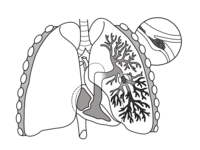
Photo from wikipedia
According to 2019 ESC guidelines for management in patients with the pulmonary embolism (PE), the computed tomographic pulmonary angiography (CTPA) is the diagnostic method of choice in suspected high-risk PE… Click to show full abstract
According to 2019 ESC guidelines for management in patients with the pulmonary embolism (PE), the computed tomographic pulmonary angiography (CTPA) is the diagnostic method of choice in suspected high-risk PE defined as patients with hemodynamic instability. In stable cases, it is recommended to assess the pre-test probability of the PE. However, CTPA with its great accuracy and wide availability in most medical centers is used as often to confirm as to exclude the diagnosis in PE suspected patients, despite the fact that it is linked with the risk of radiation and iodine-containing contrast exposure. The aim of the study was to assess the validity of CTPA use in patients with suspected PE form the perspective of multidisciplinary clinical center. We retrospectively analyzed the data of from 52,474 hospitalized patients between 01.2018 and 12.2019. A total of 261 (0.5%) consecutive patients with suspected PE (in the emergency department or during hospitalization) were included into the study. Due to suspicion of PE all patients underwent the CTPA. In this group, we analyzed all available clinical data, results of laboratory and diagnostic tests (before and after CTPA) including estimated glomerular filtration rate (eGFR), creatinine level, transthoracic echocardiography (TTE) and planar ventilation/perfusion (lung scintigraphy) scan (V/Q SPECT) if performed. The CTPA confirmed PE in 28.9% of patients. The most common final diagnoses, established in the group with negative CTPA result, include heart failure (33.9%), pneumonia (14.4%) exacerbation of chronic obstructive pulmonary disease or asthma (9.3%) and acute coronary syndrome (5.9%). Acute PE was the cause of in-hospital death in 2.4% of patients and the rate of all cause in-hospital death was 11.4%. In 54.2% of patients we observed the eGFR decline and creatinine level increase, meeting the criteria of the acute contrast-induced nephropathy in 33 of them of them (19.8%). In the group with excluded PE, mean eGFR before CTPA was 70.9ml/min/1.73m2 with the decline to mean 60.4ml/min/1.73m2 during the hospitalization (p<0.01). In patients with negative CTPA result and the worsening of the renal function mean eGFR decline was 17.8ml/min/1.73m2 (p<0.01) and mean creatinine level increase was 38.6μmol/l (p<0.01). CONSLUSIONS The initial data collected show the overuse of CTPA in suspected PE, as the diagnosis was confirmed in less than one-third of them. Although CTPA allows to exclude or confirm PE unambiguously, its use is associated with risk of acute contrast-induced nephropathy. Additionally, in patients with exacerbation of heart failure established as final diagnosis after excluding PE, intensive diuretic treatment is crucial and may cause further accompanying renal function worsening. Therefore, optimizing the diagnostic pathway in patients with suspected PE into less aggravating procedures such as TTE or V/Q SPECT is justifiable. Type of funding source: None
Journal Title: European Heart Journal
Year Published: 2020
Link to full text (if available)
Share on Social Media: Sign Up to like & get
recommendations!